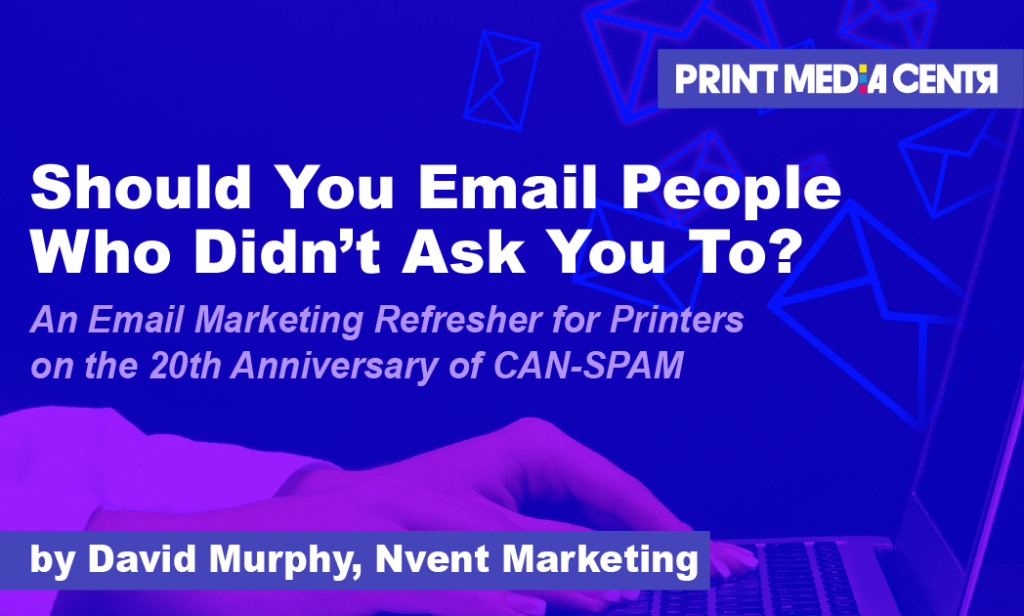
Print business owners and marketers: Raise your hand if you have ever sent email marketing to a prospect database “that you acquired somewhere.” Be honest. (OK, everyone can put their hands down now).
Email marketing is a natural complement to direct mail marketing. It’s also an efficient way to reach a lot of prospects in your target audience. The main difference between the two methods is that printed direct mail recipients in the United States (whether or not you know them) don’t require prior consent. Not so true with email.
This doesn’t mean you should never send a cold email to a stranger. You just need to follow the laws. So what should marketers (in printing companies or otherwise) know about the legality of email marketing in the effort to generate new customers?
Anti-SPAM Laws
Today, more than 30 countries and regions have passed some kind of law regarding how unsolicited commercial email can be sent: Canada has its CASL (Canada’s Anti-Spam Legislation), the UK has its EC Directive, and Europe has GDPR (General Data Protection Regulation.) GDPR, for example, requires that the sender obtain explicit consent from the recipient and detailed privacy information, and honors individuals’ rights regarding their personal data. Each anti-spam law has some variation, but the common threads have requirements about consent, transparency, and opting out. For the purpose of simplicity, this blog post focuses on the CAN-SPAM Act and email marketing in the United States.
In December 2023, we’ll reach the 20-year mark since the US Congress passed the CAN-SPAM Act of 2003. This law, according to the US Federal Trade Commission, “sets the rules for commercial email, establishes requirements for commercial messages, gives recipients the right to have you stop emailing them, and spells out tough penalties for violations.”
For US-based marketers sending commercial emails to US-based recipients, there are four elements to consider:
1. Clear identification: The CAN-SPAM Act requires marketers to clearly identify themselves as the sender of the email. In addition to accurate “From” and “Reply-To” addresses, it is recommended to include the sender’s name or the name of the organization prominently in the email. This helps recipients recognize and trust the sender, thereby increasing the likelihood of engagement and reducing the chances of the email being marked as spam.
2. Subject lines: The subject lines of email marketing campaigns help to determine whether recipients will open an email or consider it spam. Marketers should avoid using deceptive tactics or misleading language that may trick recipients into opening an email. Instead, subject lines should accurately represent the content and purpose of the email. Personalization and creativity can be used to make subject lines engaging while staying true to the email’s content.
3. Opt-out mechanism: The CAN-SPAM Act mandates that marketers provide recipients with a clear and conspicuous way to opt out of receiving future emails. Including an unsubscribe link in the email footer is a common practice. The link should be easily identifiable and functional, allowing recipients to unsubscribe with minimal effort. It is essential to process opt-out requests promptly and not engage in any further email communication with individuals who have opted out, except for legally required messages like transactional or account-related emails.
4. Third-party responsibility: When working with third-party vendors or email marketing agencies, marketers must ensure that these parties adhere to the CAN-SPAM Act’s requirements. This can be achieved through contractual agreements that outline compliance obligations, including explicit consent collection and proper identification practices. Regular communication and monitoring of the third party’s activities can help maintain compliance and mitigate any potential risks.
Ideally, email marketing campaign senders should have explicit permission from recipients. Best practices, according to a leading print marketing agency, are to use a double opt-in method, where subscribers confirm their email addresses by clicking a verification link sent to them after signing up. This helps ensure that the email address provided belongs to the intended recipient and reduces the likelihood of spam complaints. Marketers should maintain detailed records of consent, including the date, time, and source of permission, as well as any associated terms and conditions.
Penalties
Violating the CAN-SPAM Act can result in significant penalties. The FTC has the authority to enforce the Act and can impose fines of up to $41,484 per email violation. Additionally, ISPs may block or filter emails that violate the Act, affecting deliverability and sender reputation. Therefore, marketers should understand the Act’s provisions and invest in compliance measures to mitigate the risk of penalties and maintain a positive email reputation.
By adhering to the CAN-SPAM Act and other applicable regulations, marketers can build trust with their email recipients, improve deliverability rates, and create more effective and responsible email marketing campaigns. Regularly reviewing and updating email marketing practices to align with legal requirements ensures ongoing compliance and helps maintain positive relationships with subscribers.
##
Read David’s post from last month: https://printmediacentr.com/can-geofencing-and-retargeting-work-for-your-print-marketing/
Read more from David here.
 David Murphy is the founder and CEO of Nvent Marketing, a marketing agency specializing in digital marketing for the print industry. David has 30+ years of experience in the graphics and document print production industry. He has served as a board member and advisor to print organizations and associations including Sustainable Green Printing Partnership (SGP), Print Industries of America (PIA), Association for Print Technologies (APTECH), and Electronic Document Scholarship Foundation (EDSF). David was also awarded the Idealliance Soderstrom Society Award for Print Industry Leadership. David can be reached at [email protected].
David Murphy is the founder and CEO of Nvent Marketing, a marketing agency specializing in digital marketing for the print industry. David has 30+ years of experience in the graphics and document print production industry. He has served as a board member and advisor to print organizations and associations including Sustainable Green Printing Partnership (SGP), Print Industries of America (PIA), Association for Print Technologies (APTECH), and Electronic Document Scholarship Foundation (EDSF). David was also awarded the Idealliance Soderstrom Society Award for Print Industry Leadership. David can be reached at [email protected].













